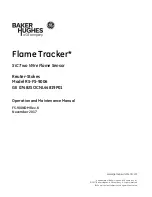
FS-9006OM
– REV K
9
4
MAINTENANCE
4.1 WARNING
Do not disconnect connector while circuit is energized (or live), unless area is known to be non-hazardous.
4.2 CAUTION
The operating temperature range of the Flame Sensor is -40°C to 150°C. Do not attempt to work on the Flame
Sensor or the cable until they have cooled to a safe handling temperature.
The Flame Sensor output will deteriorate as the lens becomes dirty. It is recommended, when initially installed,
that the signal level be recorded during normal operation. During subsequent running, the signal level should
be compared with the initial values. If a significant reduction in the signal level is noticed, then it is recommended
that the lens be cleaned at the next opportunity (with the turbine shut down and cold). Clean the lens with
isopropyl alcohol or other residue free solvent compatible with Sapphire. In order to reduce the risk of galling,
an anti-seize compound should be applied to the mounting thread prior to reinstallation of the sensor.
5
TROUBLESHOOTING
5.1 WARNING
Do not disconnect connector while circuit is energized (or live), unless area is known to be non-hazardous.
5.2 CAUTION
The operating temperature range of the Flame Sensor is
-40°C to 150°C
.
Do not
attempt to work on the
Flame Sensor or the cable until they have cooled to a safe handling temperature.
PROBLEM
CAUSE
SOLUTION
No current flows
Reversed polarity
Change polarity
Low sensitivity during
checkout or operation
Dirty lens
Grounded cable
Clean lens (Section 4.0)
Check cable for grounds
Low flame intensity signal
during operation
Misalignment of the sensor
mount
Check the squareness of all
flanges and pipes of the sensor
mount. Verify that the senor has a
clear view of the flame.
Obstructions in the line of
sight
Look for washers, or valves that
may restrict the diameter of the
sight tube.
Condensation on the lens
Over cooling can cause moisture
to condense on the lens and
reduce the signal. Reduce the
cooling until the condensation
clears up and the signal returns to
normal.

































